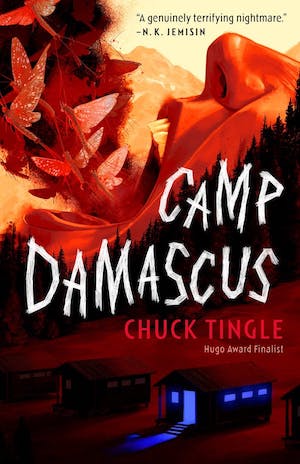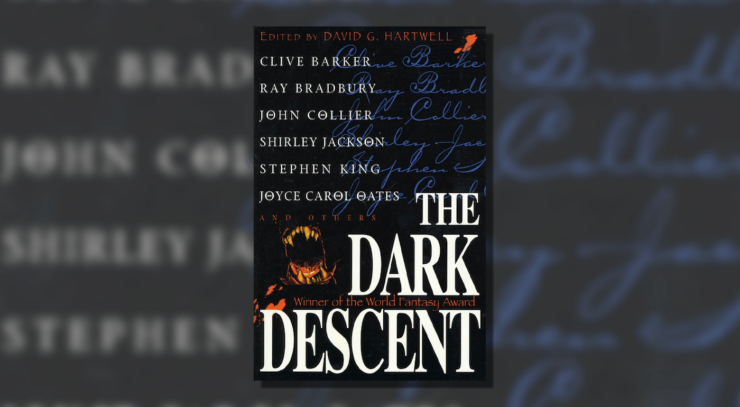Welcome back to Dissecting The Dark Descent, where we lovingly delve into the guts of David Hartwell’s seminal 1987 anthology story by story, and in the process, explore the underpinnings of a genre we all love. For an in-depth intro, here’s our intro post.
On its surface, Lucy Clifford’s “The New Mother” seems kind of standard. It’s a fabulist horror story, a kind of horror that borrows its tropes and general feel from fairy tales and fables but adds more modern touches and conception of horror. As one of the early examples of fabulist horror, it’s part of a tradition that stretches forward to modern authors including Neil Gaiman, who cites Clifford’s work as an inspiration for Coraline.
The story features two naive little girls, a woodland setting, a dark figure who tempts them, and even a horrible fate for naughty children. It’s in Clifford’s own nuances and flourishes—including the outright terror of her child protagonists’ naivete, the surrealism of the premise (no explanation is given either for the girl in the woods or how the New Mother is summoned and it’s all the more terrifying for it), and the upsetting way the ending leaves its child protagonists’ fate uncertain—that tip it from mere dark fable into an outright horror story. It’s through these distinctive touches that Clifford’s Victorian horror fable is elevated from an unsettling riff on fairy tales into a deeply disturbing classic.
Buy the Book


Camp Damascus
As always, for those who haven’t dug in to “The New Mother” yet, here’s a quick summary: Blue Eyes and Turkey live with their mother and their newborn sibling in the woods. Every week they go down to the village to check for word from their father, who is off traveling the seas. They are told not to talk to strangers and not to stray from the path, so of course the first chance they get, they speak to a little girl all alone in the forest. The girl has a strange musical instrument called a “peardrum,” sort of a lute with a box on the side. She tells Blue Eyes and Turkey that if they’re very naughty, then she’ll play it for them, and they can even hear the secret told by the little man and woman in the box. They go back to their mother and try to be their naughtiest, but it never seems to be enough. Meanwhile, as their antics escalate, their mother threatens that if they’re too naughty, she’ll leave with the baby and in her place will be a new mother with glass eyes and a wooden tail. But Blue Eyes and Turkey do so want to hear the peardrum, and the New Mother couldn’t be real, could she?
What makes “The New Mother” unusual—apart from the presence of the “New Mother” herself, a Victorian-era killbot with all the social graces of a minotaur—is that the naughtiness isn’t part of the children’s nature. Usually in these stories (the closest relative being the German folktales that boast a higher child mortality rate per single story than an entire library’s worth of ’90s YA novels), there’s a sense that the naughtiness is an inherent quality, intrinsic to the young characters. The children do something that children are predisposed to do— sucking their thumbs, leaning too far back in a chair, slurping their soup, or something similar— and then some nightmare from a parent’s id comes to torment and/or murder them. Blue Eyes and Turkey by comparison are relative innocents who don’t even understand what “naughtiness” is until the strange girl they meet in the woods tells them that they have to be naughty. Even their first attempts mirror this, with the two of them just being a little bit disagreeable and doing the opposite of what their mother says. They have to be instructed in how to be naughty. All their “naughtiness” is choreographed, and it’s clear that they definitely don’t know better. At one point, they even tell the girl in the woods “we did everything you told us to!”
More than the idea of being naughty, it feels like Clifford’s aim is to warn against temptation and manipulation. The girl in the woods serves as a Satanic figure, stringing Blue Eyes and Turkey along as they continue to do things they never thought possible, all for a nebulous (and probably fake) reward. The children destroy their lives and household all to catch a brief glimpse of happiness, following her instructions to the letter, and still it’s not enough. The girl in the woods always asks them for more, twists them further, pushes them to more terrifying acts. The two children might be the cause of the awful events in the story, as they’re the ones who actually act and thus have to face the consequence of the New Mother, but they’re portrayed as relative innocents. The girl in the woods does most of the heavy lifting, puppeting them along into naughtiness with her ever increasing demands and displeasure.
The terror here is compounded by the innocence of Blue Eyes and Turkey. They’re so eager to please their new friend that they immediately set about learning how to be naughty. They don’t even think for a moment that what they’re doing will have lasting consequences. It doesn’t help that the girl in the woods at least shows them the peardrum, whereas they have absolutely no context for what the New Mother even is. Clifford shows the damage their actions do, but there’s something deeply unnerving about watching people who have no real concept of “good” and “bad” doing bad things. It makes it even more monstrous to know that they’re doing the things out of a concept of want or out of pure curiosity rather than intentionally doing anyone harm. The complete lack of guile on the part of Blue Eyes and Turkey also makes the summoning of the New Mother feel all the more terrifying and disproportionate, as they have no idea what they’ve done until it’s far too late. The entire time, they thought it was a game—until suddenly it wasn’t. The ending even sees the two holding out hope that their mother will come back so they can make everything right again.
Hartwell introduces “The New Mother” by stating, “the allegory may be awry, but the horror is real,” and “awry” isn’t quite the right word. Despite all the horror coming from the actions of two little girls who in no way understand what it is they’re doing wrong, the plot is still the time-honored, traditional one of warning, “if you’re bad, then the monster will get you…” followed by the monster indeed coming to get them. The horror is more contextual than that, derived its potency from the innocence of the central characters. Even the ending is fairly nasty, with the two little girls living furtively in the woods while they hope their mother comes back to replace the monstrous version who now inhabits their home. Somehow, the two of them being lost in the woods is scarier than having them die at the hands of the New Mother; their fate has them taking a path that’s slower and more fraught with peril on its way to eventual doom. It does away with the certainty of their end you get in most stories, replacing it with a horrible stretch of ambiguity where we have to imagine the two children, lost and isolated, suffering and afraid.
It’s these details, this deviation from the standard formula, that makes “The New Mother” so effective both as a morality tale and as a riff on more classic fairy tales about naughty children meeting a gruesome end. While Clifford does pay her respects to the form in many ways, her nuances and evolution of the form create a brutal morality tale, and an early standout in fabulist horror.
In two weeks: Religion and allegory meet wintry ghost stories in Russell Kirk’s aggressively Catholic “There’s A Long, Long Trail A-Winding” See you then!
Sam Reader is a literary critic and book reviewer currently haunting the northeast United States. Apart from here at Tor.com, their writing can be found archived at The Barnes and Noble Science Fiction and Fantasy Book Blog and Tor Nightfire, and live at Ginger Nuts of Horror, GamerJournalist, and their personal site, strangelibrary.com. In their spare time, they drink way too much coffee, hoard secondhand books, and try not to upset people too much.










